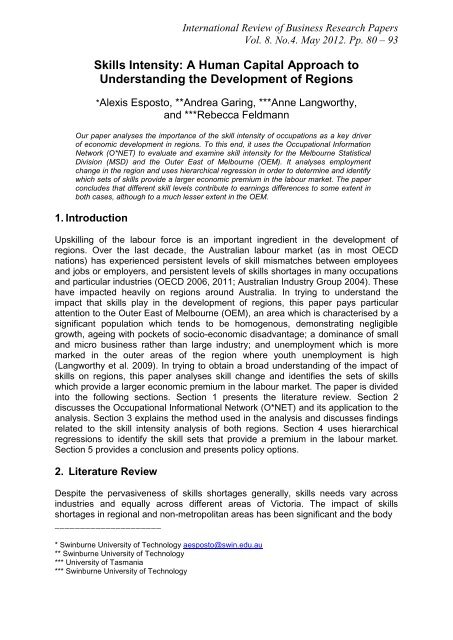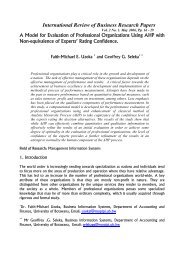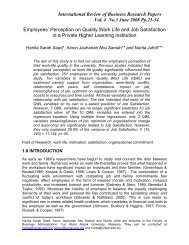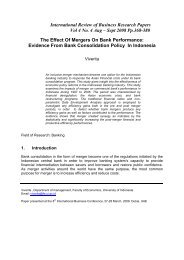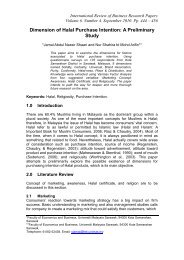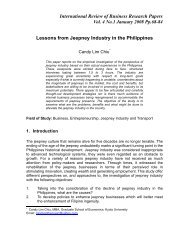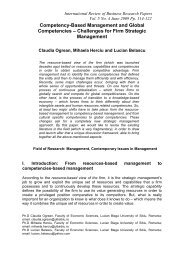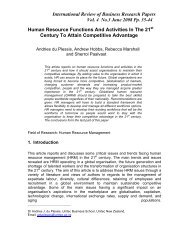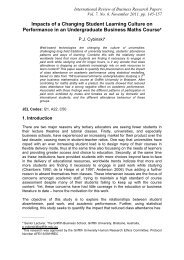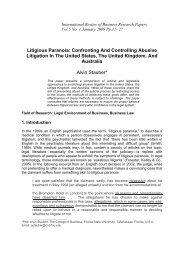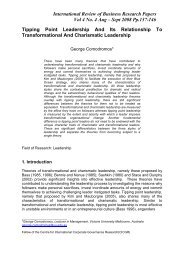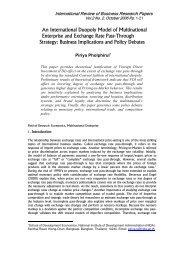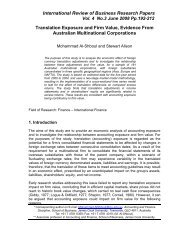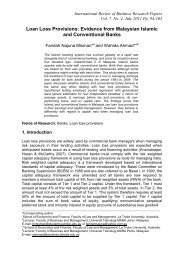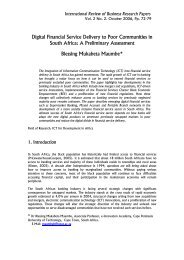Skills Intensity: A Human Capital Approach to Understanding the ...
Skills Intensity: A Human Capital Approach to Understanding the ...
Skills Intensity: A Human Capital Approach to Understanding the ...
Create successful ePaper yourself
Turn your PDF publications into a flip-book with our unique Google optimized e-Paper software.
International Review of Business Research Papers<br />
Vol. 8. No.4. May 2012. Pp. 80 – 93<br />
<strong>Skills</strong> <strong>Intensity</strong>: A <strong>Human</strong> <strong>Capital</strong> <strong>Approach</strong> <strong>to</strong><br />
<strong>Understanding</strong> <strong>the</strong> Development of Regions<br />
*Alexis Espos<strong>to</strong>, **Andrea Garing, ***Anne Langworthy,<br />
and ***Rebecca Feldmann<br />
Our paper analyses <strong>the</strong> importance of <strong>the</strong> skill intensity of occupations as a key driver<br />
of economic development in regions. To this end, it uses <strong>the</strong> Occupational Information<br />
Network (O*NET) <strong>to</strong> evaluate and examine skill intensity for <strong>the</strong> Melbourne Statistical<br />
Division (MSD) and <strong>the</strong> Outer East of Melbourne (OEM). It analyses employment<br />
change in <strong>the</strong> region and uses hierarchical regression in order <strong>to</strong> determine and identify<br />
which sets of skills provide a larger economic premium in <strong>the</strong> labour market. The paper<br />
concludes that different skill levels contribute <strong>to</strong> earnings differences <strong>to</strong> some extent in<br />
both cases, although <strong>to</strong> a much lesser extent in <strong>the</strong> OEM.<br />
1. Introduction<br />
Upskilling of <strong>the</strong> labour force is an important ingredient in <strong>the</strong> development of<br />
regions. Over <strong>the</strong> last decade, <strong>the</strong> Australian labour market (as in most OECD<br />
nations) has experienced persistent levels of skill mismatches between employees<br />
and jobs or employers, and persistent levels of skills shortages in many occupations<br />
and particular industries (OECD 2006, 2011; Australian Industry Group 2004). These<br />
have impacted heavily on regions around Australia. In trying <strong>to</strong> understand <strong>the</strong><br />
impact that skills play in <strong>the</strong> development of regions, this paper pays particular<br />
attention <strong>to</strong> <strong>the</strong> Outer East of Melbourne (OEM), an area which is characterised by a<br />
significant population which tends <strong>to</strong> be homogenous, demonstrating negligible<br />
growth, ageing with pockets of socio-economic disadvantage; a dominance of small<br />
and micro business ra<strong>the</strong>r than large industry; and unemployment which is more<br />
marked in <strong>the</strong> outer areas of <strong>the</strong> region where youth unemployment is high<br />
(Langworthy et al. 2009). In trying <strong>to</strong> obtain a broad understanding of <strong>the</strong> impact of<br />
skills on regions, this paper analyses skill change and identifies <strong>the</strong> sets of skills<br />
which provide a larger economic premium in <strong>the</strong> labour market. The paper is divided<br />
in<strong>to</strong> <strong>the</strong> following sections. Section 1 presents <strong>the</strong> literature review. Section 2<br />
discusses <strong>the</strong> Occupational Informational Network (O*NET) and its application <strong>to</strong> <strong>the</strong><br />
analysis. Section 3 explains <strong>the</strong> method used in <strong>the</strong> analysis and discusses findings<br />
related <strong>to</strong> <strong>the</strong> skill intensity analysis of both regions. Section 4 uses hierarchical<br />
regressions <strong>to</strong> identify <strong>the</strong> skill sets that provide a premium in <strong>the</strong> labour market.<br />
Section 5 provides a conclusion and presents policy options.<br />
2. Literature Review<br />
Despite <strong>the</strong> pervasiveness of skills shortages generally, skills needs vary across<br />
industries and equally across different areas of Vic<strong>to</strong>ria. The impact of skills<br />
shortages in regional and non-metropolitan areas has been significant and <strong>the</strong> body<br />
_____________________<br />
* Swinburne University of Technology aespos<strong>to</strong>@swin.edu.au<br />
** Swinburne University of Technology<br />
*** University of Tasmania<br />
*** Swinburne University of Technology
Espos<strong>to</strong>, Langworthy, Garing & Feldmann<br />
of research concerned with <strong>the</strong> skill requirements and deficits in regional areas<br />
attests <strong>to</strong> this (Department for Vic<strong>to</strong>rian Communities 2006; Department of Transport<br />
and Regional Services & Bureau of Transport and Regional Economics 2003).<br />
The prosperity of regions across Australia varies markedly and <strong>the</strong> fac<strong>to</strong>rs which<br />
contribute <strong>to</strong> <strong>the</strong>ir economic health are complex. Overall, regional Vic<strong>to</strong>ria<br />
experienced substantial employment growth in recent years. Between Oc<strong>to</strong>ber 1999<br />
and June 2006 an additional 19% of <strong>the</strong> population in regional Vic<strong>to</strong>ria gained<br />
employment, making <strong>the</strong> level of overall<br />
unemployment in some regions lower than in metropolitan Melbourne. However, as<br />
indicated in <strong>the</strong> Vic<strong>to</strong>rian Regional <strong>Skills</strong> Shortage Survey, <strong>the</strong>re were significant<br />
recruitment difficulties in many industries. Across all industries in regional Vic<strong>to</strong>ria,<br />
an average of 77% of employers attempted <strong>to</strong> recruit in <strong>the</strong> previous 12 months and<br />
12% of <strong>the</strong>ir vacancies remained unfilled. Again across all industries, 19% of<br />
employers had difficulty retaining workers. This points <strong>to</strong> <strong>the</strong> fact that skill deficits in<br />
regional areas cannot be entirely accounted for by an actual lack of appropriately<br />
skilled employees (Department for Vic<strong>to</strong>rian Communities 2006). In addition <strong>to</strong> actual<br />
shortages, regional employers often experience recruitment difficulties where<br />
appropriately qualified individuals may exist in <strong>the</strong> labour market but are not made<br />
available within a specific region.<br />
Reasons for <strong>the</strong>se difficulties are many and may include a lack of appropriate<br />
training available in regional areas, forcing residents <strong>to</strong> commute in order <strong>to</strong><br />
undertake education and training. Regional economies may be dominated by<br />
industries that are seen as ‘less desirable’ ei<strong>the</strong>r on account of <strong>the</strong>ir ‘image’ (young<br />
people may have a somewhat negative image of trade occupations including<br />
agriculture, for example), a lack of career structure (‘dead-end’ jobs) or a region may<br />
be dominated by industries that are considered <strong>to</strong> be unstable and seasonal.<br />
2.1 Successful Regions<br />
<strong>Human</strong> capital development, in <strong>the</strong> form of upskilling of <strong>the</strong> labour force, is a crucial<br />
component and ingredient for <strong>the</strong> successful development of regions. Local skills,<br />
local jobs and local knowledge are important <strong>to</strong> <strong>the</strong> sustainability of local<br />
communities. Regions with highly diverse economies exhibit more stable economies<br />
and are less subject <strong>to</strong> volatile growth patterns (Bureau of Transport and Regional<br />
Economics 2003). O<strong>the</strong>r fac<strong>to</strong>rs which influenced regional economic growth were <strong>the</strong><br />
availability of facilities, remoteness, leadership and a strong skill base. Regionally.<br />
success breeds success, and thus regions where <strong>the</strong> 'requisite skill and knowledge<br />
capacity are in place are more likely <strong>to</strong> attract viable and dynamic industries’<br />
(National Institute of Economic and Industry Research 2004, cited in Langworthy &<br />
Brunt 2005).<br />
The creation of local jobs and <strong>the</strong> retention of <strong>the</strong> local working population has<br />
significant advantages for local communities and regional economies, including<br />
fostering an increasing a sense of community.<br />
The improvement of <strong>the</strong> skill and knowledge capacity of residents, whilst essential<br />
for <strong>the</strong> local economy, also has wider benefits. Many studies demonstrate <strong>the</strong><br />
81
Espos<strong>to</strong>, Langworthy, Garing & Feldmann<br />
benefits of community members who have university education. For example, higher<br />
education fosters democratic participation (Harper, cited in Benson & Harkavy 2002;<br />
Kezar, Chambers & Burkhardt 2005). Graduates are more likely <strong>to</strong> participate and<br />
accept diversity in <strong>the</strong>ir communities and are over three times more likely <strong>to</strong> belong<br />
<strong>to</strong> a voluntary organisation than non-graduates (Purcell, Elias & Wil<strong>to</strong>n 2004), They<br />
also experience better health and wellbeing (Hillman & McMillan 2005; King 1999;<br />
Kretzmann & McKnight 1993), are less likely <strong>to</strong> be involved in crime (Chapman et al.<br />
2002) and are significantly more likely <strong>to</strong> hold positive attitudes <strong>to</strong>wards race and<br />
gender equality (Purcell, Elias & Wil<strong>to</strong>n 2004).<br />
In addition, graduates live healthier lifestyles and are less likely <strong>to</strong> smoke, <strong>to</strong> be<br />
obese or <strong>to</strong> suffer from depression and more likely <strong>to</strong> report ‘excellent’ health<br />
(Wilberforce 2005). Higher education qualifications are also associated with less<br />
physical decline, depression, loneliness and social loss, and positively associated<br />
with continuous growth in ageing people (Steverink et al. 2001). The benefits are<br />
also intergenerational. Graduates are more likely <strong>to</strong> take an interest in <strong>the</strong>ir own<br />
children’s education and <strong>to</strong> be involved with <strong>the</strong>ir school, fac<strong>to</strong>rs which are predic<strong>to</strong>rs<br />
of schooling success (Purcell, Elias & Wil<strong>to</strong>n 2004). The above discussion highlights<br />
<strong>the</strong> importance of skills in <strong>the</strong> continued development and wellbeing of communities,<br />
regions and nations. One way of achieving a good understanding of <strong>the</strong> skill needs<br />
of communities, a changing economy and labour market is through a skills change<br />
analysis using <strong>the</strong> Occupational Information Network (O*NET).<br />
2.2 The O*NET: A Suggested <strong>Approach</strong> <strong>to</strong> <strong>Understanding</strong> <strong>the</strong> Regional Skill<br />
Levels<br />
The O*NET is an extensive and comprehensive database that describes <strong>the</strong><br />
attributes and characteristics of occupations and workers. Its first version was<br />
launched in 1998 and is known as O*NET 98. Considered <strong>to</strong> be <strong>the</strong> most<br />
comprehensive standard source of occupational information in <strong>the</strong> US, it offers<br />
statistical information that can be applied <strong>to</strong> <strong>the</strong> Australian context <strong>to</strong> analyse labour<br />
market change.<br />
The O*NET was developed by a consortium led by <strong>the</strong> US Department of Labor <strong>to</strong><br />
replace <strong>the</strong> Dictionary of Occupational Titles (DOT) which had been conceived in <strong>the</strong><br />
1930s and was last published in 1991. The DOT was developed in an industrial<br />
economy during a time that emphasised blue-collar occupations. It was updated<br />
periodically and proved very useful for more than six decades.<br />
The occupational information in <strong>the</strong> O*NET is organised in a relational database<br />
which identifies, defines and describes <strong>the</strong> comprehensive elements of job<br />
performance. It contains hundreds of information items on job requirements, worker<br />
attributes and <strong>the</strong> content and context of work, capturing what people do in <strong>the</strong>ir day<strong>to</strong>-day<br />
activities.<br />
2.3 The O*NET Content Model<br />
The Content Model is <strong>the</strong> conceptual foundation of <strong>the</strong> O*NET. It was developed by<br />
Mumford and Peterson (1999), using research on job and organisational analysis,<br />
and embodies a framework that reflects <strong>the</strong> character of occupations (i.e. using joboriented<br />
descrip<strong>to</strong>rs) and people (i.e. using worker-oriented descrip<strong>to</strong>rs). The<br />
82
Espos<strong>to</strong>, Langworthy, Garing & Feldmann<br />
Content Model also allows occupational information <strong>to</strong> be applied across jobs,<br />
industry sec<strong>to</strong>rs (by using cross-occupational descrip<strong>to</strong>rs) and within occupations<br />
(using occupation-specific descrip<strong>to</strong>rs).<br />
Figure 1: Six Domains of <strong>the</strong> O*NET Content Model<br />
Source: O*NET Resource Centre (2012).<br />
2.4 O*NET Skill Descrip<strong>to</strong>rs Used for This Analysis<br />
The approach taken by O*NET <strong>to</strong> define skill is that of Mumford and Peterson (1999)<br />
who define it as a set of general procedures that underlie <strong>the</strong> effective acquisition<br />
and application of knowledge in different areas of endeavour. The implication of this<br />
definition is threefold. Firstly, skills are innately linked <strong>to</strong> knowledge, learning,<br />
practice, education and experience. For example, a person cannot acquire or apply<br />
skills without learning, practising, being exposed <strong>to</strong> education, experiencing or<br />
acquiring knowledge. Secondly, skills can be seen as general procedures that are<br />
necessary for <strong>the</strong> performance of multiple tasks. These tasks, however, must form<br />
part of a given domain of skills such as social skills, basic skills or problem solving<br />
skills. Finally, skills are not constant attributes of individuals that remain unchanged<br />
over time. They can be acquired (sometimes <strong>the</strong>y can be lost) and developed as a<br />
result of new learning, experience or newly acquired knowledge. Thus <strong>the</strong> O*NET<br />
can provide a good description of human capital (<strong>the</strong> s<strong>to</strong>ck of productive skills and<br />
technical knowledge embodied in labour), although it has not been widely used in<br />
labour market research.<br />
83
Espos<strong>to</strong>, Langworthy, Garing & Feldmann<br />
Given <strong>the</strong> above, Mumford and Peterson (1999) argue that skills are not onedimensional<br />
and require a variety of taxonomies. They divide <strong>the</strong> taxonomy of skill<br />
in<strong>to</strong> two broad categories. The first is referred <strong>to</strong> as basic skills, defined as <strong>the</strong><br />
developed capacities that facilitate learning or <strong>the</strong> attainment of new knowledge.<br />
These are subdivided in<strong>to</strong> two fur<strong>the</strong>r categories: content and process skills, which<br />
are made up of six and four skill variables respectively, out of a <strong>to</strong>tal of 46 skills that<br />
comprise <strong>the</strong> complete O*NET skill taxonomy. Content skills can be broadly defined<br />
in terms of those capabilities that allow people <strong>to</strong> acquire information and convey it <strong>to</strong><br />
o<strong>the</strong>rs. They represent <strong>the</strong> structures required <strong>to</strong> work with and acquire o<strong>the</strong>r skills.<br />
This category includes skills such as reading, writing, listening, speaking,<br />
ma<strong>the</strong>matics and science. These skills are also widely seen as fundamental in <strong>the</strong><br />
provision of any sound educational system.<br />
Process skills are seen as those that facilitate <strong>the</strong> acquisition of content across<br />
domains. The ability <strong>to</strong> think critically is thus part and parcel of such skills. This is<br />
closely related <strong>to</strong> a second kind of general learning skill, referred <strong>to</strong> as active<br />
learning. Ano<strong>the</strong>r process-oriented skill takes <strong>the</strong> form of learning strategy. This uses<br />
a variety of approaches when learning new things. Finally, moni<strong>to</strong>ring represents an<br />
ongoing appraisal of <strong>the</strong> success of an individual’s efforts because it assists <strong>the</strong>m in<br />
assessing how well <strong>the</strong>y are learning something or doing a particular task. The<br />
second classification of skills is defined in <strong>the</strong> O*NET as <strong>the</strong> capacities that facilitate<br />
individuals <strong>to</strong> perform effectively in a variety of job settings. This skill definition is also<br />
known as Cross-Functional <strong>Skills</strong> and in <strong>the</strong> O*NET Content Model is based on <strong>the</strong><br />
notion of socio-technical systems <strong>the</strong>ory.<br />
3. Methodology: The Skill Composition of Employment: MSD and<br />
OEM<br />
In <strong>the</strong> analysis that follows, <strong>the</strong> O*NET measures of skill are applied <strong>to</strong> investigate<br />
changes <strong>to</strong> <strong>the</strong> composition of full-time and part-time employment for men and<br />
women. We explore <strong>the</strong> following questions:<br />
� How have <strong>the</strong> occupational requirements of workers in <strong>the</strong> MSD and <strong>the</strong> OEM in<br />
terms of O*NET skill intensities changed between 1991 and 2010?<br />
� What areas of skill are most important in terms of employment growth for both <strong>the</strong><br />
MSD and <strong>the</strong> OEM?<br />
3.1 The Skill and Knowledge <strong>Intensity</strong> of Occupations: MSD and OEM<br />
This section considers <strong>the</strong> worker requirements of occupations by analysing <strong>the</strong><br />
overall skill intensity change of occupations. To describe changes in <strong>the</strong> skill intensity<br />
of occupations, employment indices of skill intensity were created using <strong>the</strong> following<br />
equation:<br />
SK<br />
E<br />
�<br />
j SKi<br />
i�1<br />
ALL � m<br />
n<br />
( I<br />
�<br />
j�1<br />
. L<br />
E<br />
j<br />
SKi<br />
) / n<br />
Equation 1<br />
84
Espos<strong>to</strong>, Langworthy, Garing & Feldmann<br />
The above index measures <strong>the</strong> intensity of skill in occupations across <strong>the</strong> whole of<br />
<strong>the</strong> labour market and allows us <strong>to</strong> compare changes <strong>to</strong> <strong>the</strong> composition of skill in<br />
terms of job types, e.g. female full-time employment. Hence, <strong>to</strong> say that on average<br />
<strong>the</strong> skill intensity in a given job type has increased is <strong>to</strong> say that on average <strong>the</strong><br />
composition of employment in that job type has changed because of:<br />
� Growth in occupations that require a higher level of skill intensity;<br />
� A decline in <strong>the</strong> number of jobs that require lower levels of skill intensity;<br />
� Both an increase in occupations that require higher levels of skill intensity and a<br />
decline in occupations that require lower levels of skill intensity.<br />
3.2 Employment Change: Australia, MSD and OEM<br />
Before delving in<strong>to</strong> an analysis of <strong>the</strong> skill intensity changes in <strong>the</strong> labour force of<br />
both <strong>the</strong> MSD and <strong>the</strong> OEM, it is important <strong>to</strong> note <strong>the</strong> important role of part-time<br />
employment in Australia. The labour market has experienced a major transformation<br />
over <strong>the</strong> last three decades. A major feature of this change has been <strong>the</strong> increasing<br />
diversity in <strong>the</strong> nature of work and types of employment (VandenHeuvel and Wooden<br />
2000). For example, up until <strong>the</strong> 1970s, most Australian workers were in permanent<br />
full-time employment. During <strong>the</strong> early 1970s, just over one in ten worked in parttime<br />
employment, defined by <strong>the</strong> ABS as less than 35 hours per week. By 2002<br />
nearly one in three employees were employed on a part-time basis (ABS 2002).<br />
Fur<strong>the</strong>rmore, in <strong>the</strong> early 1980s, alternative work arrangements began <strong>to</strong> flourish,<br />
especially casual employment (Espos<strong>to</strong> 2008a, p. 84).<br />
Two major fac<strong>to</strong>rs have contributed <strong>to</strong>wards a trend that promotes labour market<br />
change, namely, demand and supply fac<strong>to</strong>rs, and institutional forces. The desire of<br />
many workers <strong>to</strong> combine responsibilities and personal interests with participation in<br />
<strong>the</strong> labour market has impacted <strong>the</strong> supply side. Such examples are <strong>the</strong> entry of<br />
many married women in<strong>to</strong> <strong>the</strong> labour market who are willing <strong>to</strong> combine home and<br />
family duties with employment arrangements such as casual and/or part-time work.<br />
The opportunity for women <strong>to</strong> do so and for students <strong>to</strong> combine study and work can<br />
be seen as a positive outcome, in that it has improved both groups’ social and<br />
economic wellbeing.<br />
85
Espos<strong>to</strong>, Langworthy, Garing & Feldmann<br />
Table 1: Employment Change by Region, 1991-2010 i<br />
Region Persons employed<br />
Change 1991-<br />
2010<br />
1991 2010<br />
MSD 1,252,430 1,747,552 39.5<br />
Outer East of Melbourne<br />
Knox 54,683 72,177 32.0<br />
Maroondah 38,427 54,002 40.5<br />
Yarra<br />
Ranges<br />
53,798 74,117 37.8<br />
Men Full-time<br />
Outer East of Melbourne<br />
MSD 597,370 708,048 18.5<br />
Knox 27,096 32,058 18.3<br />
Maroondah 18,441 22,104 19.9<br />
Yarra<br />
Ranges<br />
26,546 30,227 13.9<br />
Men Part-time<br />
MSD 107,359 222,753 107.5<br />
Outer East of Melbourne<br />
Knox 4,101 7,269 77.3<br />
Maroondah 3,106 6,696 115.6<br />
Yarra<br />
Ranges<br />
4,457 9,355 109.9<br />
Women Full-time<br />
MSD 319,414 409,023 28.1<br />
Outer East of Melbourne<br />
Knox 12,733 15,797 24.1<br />
Maroondah 9,224 11,416 23.8<br />
Yarra<br />
Ranges<br />
11,651 14,310 22.8<br />
Women Part-time<br />
MSD 319,414 378,808 18.6<br />
Outer East of Melbourne<br />
Knox 10,754 17,357 61.4<br />
Maroondah 7,657 14,319 87.0<br />
Yarra<br />
11,145 21,082 89.2<br />
Ranges<br />
Source: ABS Census, 1991, 1996, 2001 and 2006 and author’s estimates. Not<br />
stated and inadequately described not included in estimates.<br />
For both <strong>the</strong> MSD and OEM, <strong>the</strong>se employment arrangements (<strong>the</strong> increase in parttime<br />
and casual work ii ) have taken a more prominent share of <strong>to</strong>tal employment.<br />
Table 1 indicates that <strong>the</strong> growth in part-time employment has clearly outstripped <strong>the</strong><br />
growth in full-time employment in all categories, except women in <strong>the</strong> MSD. For<br />
86
Espos<strong>to</strong>, Langworthy, Garing & Feldmann<br />
example, in <strong>the</strong> MSD <strong>to</strong>tal employment grew by 39.5% between 1991 and 2010, but<br />
full-time work grew by a smaller percentage. When compared <strong>to</strong> full-time work, parttime<br />
work for men grew more than fivefold. Women, on <strong>the</strong> o<strong>the</strong>r hand, experienced<br />
stronger growth in full-time work than in part-time work in <strong>the</strong> MSD. This pattern was<br />
not, however, replicated for Knox, Maroondah and Yarra Ranges. Men in<br />
employment in <strong>the</strong> OEM experienced similar trends <strong>to</strong> <strong>the</strong> MSD.<br />
Table 1 reveals that <strong>the</strong> nature of employment creation changed considerably over<br />
<strong>the</strong> period, with a twofold shift characterised by slower growth in full-time<br />
employment creation and an acceleration in part-time employment creation.<br />
3.3 Skill <strong>Intensity</strong> of Occupations in Full-Time Employment: MSD and OEM<br />
The analysis that follows begins by examining <strong>the</strong> changes <strong>to</strong> <strong>the</strong> intensity of skill for<br />
<strong>to</strong>tal and full-time employment and <strong>the</strong>n proceeds with <strong>the</strong> same analysis for parttime<br />
work. The comparisons are made between <strong>the</strong> changes of skill intensity and<br />
knowledge intensity of occupations in <strong>the</strong> MSD and OEM.<br />
Table 2 shows changes in <strong>the</strong> skill intensity of occupations and growth in<br />
employment for <strong>the</strong> period 1991 <strong>to</strong> 2010, using Equation 1. For every year, for <strong>the</strong><br />
<strong>to</strong>tal employed population and for men and women, <strong>the</strong> skill intensity index is higher<br />
for <strong>the</strong> MSD than <strong>the</strong> OEM. This indicates that <strong>the</strong> skill occupations in <strong>the</strong> MSD<br />
require higher skill levels. The skill intensity results show that for <strong>to</strong>tal employment<br />
job creation in <strong>the</strong> MSD, skilled occupations are favoured. The skill intensity of jobs<br />
grew by 6.61%, compared <strong>to</strong> a fall of 1.4% for <strong>the</strong> OEM.<br />
In terms of full-time work, <strong>the</strong> trends are different for men and women, particularly in<br />
<strong>the</strong> OEM where <strong>the</strong> skill intensity of occupations increased for women, but fell for<br />
men. For <strong>the</strong> MSD, <strong>the</strong> skill intensity of occupations increased for both men and<br />
women, but <strong>the</strong> growth was much stronger for women, indicating <strong>the</strong> increasingly<br />
important role of women in full-time employment. These same trends are also found<br />
for <strong>the</strong> OEM but are of a lower magnitude. This demonstrates a trend similar <strong>to</strong> that<br />
of <strong>the</strong> Australian economy (Espos<strong>to</strong> 2008a, p. 166).<br />
For overall employment, job creation in <strong>the</strong> OEM is favouring occupations which<br />
require lower skill levels compared <strong>to</strong> <strong>the</strong> MSD for <strong>to</strong>tal employment. When<br />
disaggregating <strong>the</strong> data in terms of job type (i.e. male and female full-time), <strong>the</strong><br />
results show different trends. Employment creation in full-time work in <strong>the</strong> OEM<br />
shows trends of low skill intensive job creation. Conversely, for women <strong>the</strong> trends in<br />
<strong>the</strong> OEM show that job creation favours higher skilled occupations. These trends are<br />
similar <strong>to</strong> those found in <strong>the</strong> MSD, however, <strong>the</strong> magnitude of <strong>the</strong> increase in skill<br />
intensive employment in <strong>the</strong> MSD is stronger in terms of growth for both men and<br />
women.<br />
87
Espos<strong>to</strong>, Langworthy, Garing & Feldmann<br />
Table 2: Skill <strong>Intensity</strong> Scores and Indices Change for Total Employment and<br />
for Male and Female Full-Time Employment, MSD and OEM, 1991-2010<br />
Year MSD OEM MSD OEM MSD OEM<br />
Skill <strong>Intensity</strong> Index<br />
Total employment Male full-time Female full-time<br />
1991 6.52 6.43 7.3 7.28 6.23 6.04<br />
1996 6.65 6.4 7.4 7.21 6.74 6.36<br />
2001 6.77 6.38 7.52 7.15 7.08 6.55<br />
2006 6.86 6.36 7.61 7.11 7.43 6.77<br />
2010 6.95 6.34 7.70 7.07 7.80 7.00<br />
Chan<br />
6.61 -1.40 5.49 -2.88 25.16 15.85<br />
ge<br />
Source: ABS Census, 1991, 1996 and 2006. Authors’ estimates for 2010. Not<br />
stated and inadequately described not included in calculations.<br />
4. Identifying <strong>Skills</strong> that Provide a Premium in <strong>the</strong> Labour Market<br />
This section estimates <strong>the</strong> relationship between skill, and wages and employment<br />
growth, using hierarchical regression analysis.<br />
4.1 The Value of Marketable <strong>Skills</strong><br />
In order <strong>to</strong> categorise and identify <strong>the</strong> most marketable skills in <strong>the</strong> Melbourne<br />
Statistical Division (MSD) and Outer Eastern Region of Melbourne (OEM), this study<br />
takes as its conceptual framework <strong>the</strong> O*NET. The O*NET Content Model defines<br />
worker requirements, or skills, as <strong>the</strong> attributes that individuals develop or acquire in<br />
<strong>the</strong> context of <strong>the</strong>ir work performance, and divides <strong>the</strong>m in<strong>to</strong> two broad categories:<br />
Basic <strong>Skills</strong>, which are necessary in order <strong>to</strong> acquire and assimilate new knowledge;<br />
and Cross-Functional <strong>Skills</strong>, which relate <strong>to</strong> <strong>the</strong> activities that are undertaken across<br />
a range of occupations. Using this framework, comparisons of worker requirements<br />
can be made across a wide range of vocational fields and environments in <strong>the</strong> form<br />
of cross-occupational descrip<strong>to</strong>rs, thus allowing <strong>the</strong> identification of generalised skill<br />
requirements of a geographical region.<br />
As <strong>the</strong> Basic <strong>Skills</strong> were foundational <strong>to</strong> <strong>the</strong> acquisition of <strong>the</strong> more complex Cross-<br />
Functional <strong>Skills</strong>, it would be expected that those skills would only influence earnings<br />
discrepancy through <strong>the</strong>ir effect on <strong>the</strong> Cross-Functional <strong>Skills</strong> and would not in and<br />
of <strong>the</strong>mselves provide a premium in <strong>the</strong> labour market. This is illustrated in Figure 2.<br />
Figure 2: Expected Link between <strong>Skills</strong> and Labour Market Premium<br />
88
Espos<strong>to</strong>, Langworthy, Garing & Feldmann<br />
<strong>Skills</strong> classified by <strong>the</strong> O*NET as Basic <strong>Skills</strong> are those six that are essential<br />
background structures that facilitate learning, called Content <strong>Skills</strong>, namely, reading<br />
comprehension, active learning, writing, speaking, ma<strong>the</strong>matics and science; and <strong>the</strong><br />
four Process <strong>Skills</strong>, which are procedural skills which contribute <strong>to</strong> rapid acquisition<br />
of skills, namely, learning strategies, critical thinking, active learning and moni<strong>to</strong>ring.<br />
Toge<strong>the</strong>r <strong>the</strong> Content and Process <strong>Skills</strong> form <strong>the</strong> basis upon which Cross-<br />
Functional <strong>Skills</strong> develop.<br />
Cross-Functional <strong>Skills</strong>, on <strong>the</strong> o<strong>the</strong>r hand, are viewed as developed capacities that<br />
facilitate <strong>the</strong> performance of specific activities common <strong>to</strong> multiple jobs. There are 36<br />
Cross-Functional <strong>Skills</strong> that form five clusters: complex problem solving skills, social<br />
skills, technical skills, systems skills and resource management skills. These clusters<br />
would be expected <strong>to</strong> be differentially valuable <strong>to</strong> <strong>the</strong> labour market dependent on,<br />
among o<strong>the</strong>r things, <strong>the</strong> dynamic forces present in <strong>the</strong> regional economy and <strong>the</strong><br />
characteristics of that particular supply of labour.<br />
4.2 Methodology<br />
The hypo<strong>the</strong>sised skill cluster model was tested using hierarchical regression<br />
analysis. iii The use of regression analysis is appropriate when examining <strong>the</strong> relative<br />
importance of predic<strong>to</strong>rs, thus it is appropriate here as it enables conclusions <strong>to</strong> be<br />
drawn about <strong>the</strong> relative effects of individual skills on earnings discrepancies. The<br />
data met all assumptions for regression analysis. Tolerance figures indicated that<br />
bivariate correlations were not so strong as <strong>to</strong> render any particular variable<br />
redundant in a regression, although prevented <strong>the</strong> use of latent fac<strong>to</strong>rs. Hierarchical<br />
regression allows for <strong>the</strong> testing of a mediation hypo<strong>the</strong>sis, whereby <strong>the</strong>re is a<br />
hypo<strong>the</strong>sised chain of influence. In <strong>the</strong> skills cluster model, it was expected that <strong>the</strong><br />
Basic <strong>Skills</strong> would have no direct influence on earnings discrepancy, but indirectly<br />
affect earnings discrepancy by facilitating <strong>the</strong> acquisition of skills which were<br />
considered valuable in <strong>the</strong> labour market. The Basic <strong>Skills</strong> cluster was entered in <strong>the</strong><br />
first model, followed by <strong>the</strong> Cross-Functional <strong>Skills</strong> clusters in <strong>the</strong> subsequent<br />
model. iv<br />
4.3 Valuable <strong>Skills</strong> in <strong>the</strong> Labour Market: Aggregate Data<br />
In <strong>the</strong> MSD, 18.4% of earnings discrepancy can be explained by skills. In stage one<br />
of <strong>the</strong> regression, <strong>the</strong> Basic <strong>Skills</strong> alone (six Content and four Process <strong>Skills</strong>) explain<br />
12.1%. In stage two, <strong>the</strong> introduction of Cross-Functional <strong>Skills</strong> (social, problem<br />
solving, technical, systems and resource management) explain a fur<strong>the</strong>r 6.3% of<br />
earnings discrepancy, but of <strong>the</strong>se, only systems skills contribute significantly, while<br />
<strong>the</strong> Basic <strong>Skills</strong> no longer contribute <strong>to</strong> <strong>the</strong> model (see Figure 3). Overall this<br />
suggests, as expected, that <strong>the</strong> Basic <strong>Skills</strong> only influence earnings discrepancy<br />
through <strong>the</strong>ir effect on more complex skills. However, unexpectedly, <strong>the</strong> only skills<br />
cluster <strong>to</strong> contribute <strong>to</strong> earnings discrepancy is <strong>the</strong> systems skills cluster. That is, in<br />
<strong>the</strong> Melbourne metropolitan area, <strong>the</strong> acquisition of Basic <strong>Skills</strong> like reading and<br />
writing is only useful inasmuch as it allows greater acquisition of systems skills and<br />
thus greater earnings discrepancy.<br />
89
Espos<strong>to</strong>, Langworthy, Garing & Feldmann<br />
Figure 3: Relationship between <strong>Skills</strong> and Labour Market Premium in<br />
Metropolitan Melbourne<br />
The Systems <strong>Skills</strong> cluster comprises <strong>the</strong> Cross-Functional <strong>Skills</strong> that are utilised <strong>to</strong><br />
understand, moni<strong>to</strong>r and improve socio-technical systems. It encompasses <strong>the</strong> skills<br />
of Judgement and Decision-Making, which entails cost-benefit analysis of relative<br />
merits of potential actions and <strong>the</strong> choice of <strong>the</strong> most advantageous alternative;<br />
Systems Analysis, which involves determination of <strong>the</strong> most efficient methodology for<br />
a system and <strong>the</strong> effects on that system of both internal and external influences; and<br />
Systems Evaluation, comprising skills in identifying appropriate indica<strong>to</strong>rs of system<br />
performance and effective methods for improving performance relative <strong>to</strong> <strong>the</strong> goals<br />
of <strong>the</strong> system.<br />
In metropolitan Melbourne, possession of <strong>the</strong> aforementioned systems skills<br />
provides a premium in <strong>the</strong> labour market, resulting in an extra 18% in earnings over<br />
and above that earned by individuals who do not possess such skills. Fur<strong>the</strong>rmore,<br />
<strong>the</strong> acquisition of social skills, problem solving skills, technical skills and resource<br />
management skills does not lead <strong>to</strong> a premium in <strong>the</strong> labour market.<br />
Fur<strong>the</strong>r analysis was undertaken <strong>to</strong> determine which of <strong>the</strong> individual skills provides<br />
<strong>the</strong> greatest earnings discrepancy. A hierarchical regression revealed that in<br />
metropolitan Melbourne, <strong>the</strong> most important of <strong>the</strong> Basic <strong>Skills</strong> is Critical Thinking,<br />
which alone accounts for 14.4% of <strong>the</strong> variation in earnings discrepancy. However,<br />
once again, this skill does not directly provide a premium in <strong>the</strong> labour market,<br />
instead being only influential in its ability <strong>to</strong> affect <strong>the</strong> acquisition of Judgement and<br />
Decision-Making skills which emerged as <strong>the</strong> most important of <strong>the</strong> Systems skills.<br />
Critical thinking is a Basic Process skill involving <strong>the</strong> use of logic and reasoning <strong>to</strong><br />
identify strengths and weaknesses of alternative solutions, conclusions or<br />
approaches <strong>to</strong> problems, thus a direct precursor of <strong>the</strong> ability <strong>to</strong> make sound<br />
judgements. This relationship is <strong>the</strong>refore not unexpected. Perhaps surprising is that<br />
<strong>to</strong>ge<strong>the</strong>r <strong>the</strong>se two skills account for 17.7% of <strong>the</strong> variation in earnings discrepancy,<br />
which is almost all of <strong>the</strong> variation accounted for by both <strong>the</strong> Basic and Systems<br />
clusters (18.4%). This suggests that in metropolitan Melbourne, individuals wishing<br />
<strong>to</strong> gain a premium in <strong>the</strong> labour market should focus <strong>the</strong>ir educational efforts on<br />
acquiring skills in critical thinking, in order <strong>to</strong> facilitate and build skills in judgement<br />
and decision-making.<br />
4.4 Valuable <strong>Skills</strong> in <strong>the</strong> Labour Market: Regional Data<br />
The results for <strong>the</strong> OEM region are very different <strong>to</strong> <strong>the</strong> overall Melbourne analysis,<br />
with skills explaining only 4.6% of earnings discrepancy. Fur<strong>the</strong>rmore, <strong>the</strong> only skills<br />
<strong>to</strong> result in this relatively small premium are <strong>the</strong> Basic <strong>Skills</strong> cluster. Cross-functional<br />
skill clusters fail <strong>to</strong> contribute any explanation over and above <strong>the</strong> Basic <strong>Skills</strong> (see<br />
Figure 4).<br />
90
Espos<strong>to</strong>, Langworthy, Garing & Feldmann<br />
Figure 4: Relationship Between <strong>Skills</strong> and Labour Market Premium in <strong>the</strong><br />
Region<br />
This suggests that in <strong>the</strong> region, <strong>the</strong> acquisition of more complex, higher skills will<br />
not result in a greater premium in earnings. Fur<strong>the</strong>rmore, whatever earnings<br />
discrepancies do exist appear <strong>to</strong> be mostly due <strong>to</strong> fac<strong>to</strong>rs o<strong>the</strong>r than skills.<br />
In terms of <strong>the</strong> most important individual skills, Active Learning emerged as <strong>the</strong> most<br />
important of <strong>the</strong> Basic <strong>Skills</strong>, alone accounting for all <strong>the</strong> premium evident in <strong>the</strong><br />
regional labour market. The o<strong>the</strong>r Basic <strong>Skills</strong> appear not <strong>to</strong> impact significantly on<br />
earnings discrepancy. Active Learning involves attending fully <strong>to</strong> information<br />
provided by o<strong>the</strong>rs and ensuring comprehension by committing time or energy <strong>to</strong><br />
understanding, or asking questions when appropriate. Of all basic and complex<br />
skills, this is <strong>the</strong> one skill that can provide a premium in earnings in <strong>the</strong> region.<br />
5. Conclusion<br />
The study found that, over <strong>the</strong> 1991-2010 period, <strong>the</strong> growth of jobs requiring higher<br />
level skill intensity was concentrated in <strong>the</strong> MSD. In contrast, <strong>the</strong> OEM was<br />
characterised by job creation requiring lower skill levels, perhaps indicating that<br />
people who live in <strong>the</strong> inner areas of Melbourne have access <strong>to</strong> occupations that<br />
require higher skill levels and as a result command a higher premium in <strong>the</strong> labour<br />
market.<br />
Fur<strong>the</strong>rmore, a comparison of <strong>the</strong> MSD and <strong>the</strong> OEM suggests that skills contribute<br />
<strong>to</strong> earnings discrepancy <strong>to</strong> some extent in both cases, although <strong>to</strong> a much lesser<br />
extent in <strong>the</strong> OEM region. While overall in <strong>the</strong> MSD critical thinking will facilitate <strong>the</strong><br />
acquisition of <strong>the</strong> systems skill of Judgement and Decision-Making and thus result in<br />
a clear premium (18.4%), no such premium exists in <strong>the</strong> OEM. The only skill <strong>to</strong><br />
contribute <strong>to</strong> earnings discrepancy in <strong>the</strong> region is Active Learning which is only<br />
associated with a relatively small increase in wages (4.3%).<br />
This, of course, presumes <strong>the</strong> continuation of <strong>the</strong> existing economic and social<br />
structure in <strong>the</strong> region. Given <strong>the</strong> levels of declining skill intensity identified in <strong>the</strong><br />
occupations of regional residents in Table 2, it is likely that strategies <strong>to</strong> address<br />
regional industry structure and growth will be required.<br />
Endnotes<br />
i Estimates of employment growth for 2010 are obtained using a linear trend method matching <strong>the</strong> 1991, 1996, 2001 and 2006<br />
census employment data <strong>to</strong> 2010. This was done by using <strong>the</strong> least squares methodology..<br />
ii Unfortunately, it is not possible <strong>to</strong> comment on <strong>the</strong> rise of casual employment for both <strong>the</strong> MSD and OEM because <strong>the</strong><br />
Australian census does not provide information on casual employment.<br />
iii It was initially intended for <strong>the</strong> hypo<strong>the</strong>sised model <strong>to</strong> be tested by using structural equation<br />
modelling; however, a high degree of multicollinearity both with and between O*NET clusters<br />
prevented <strong>the</strong> use of latent fac<strong>to</strong>rs.<br />
91
Espos<strong>to</strong>, Langworthy, Garing & Feldmann<br />
iv Almost all skill variables were moderately <strong>to</strong> severely positively skewed. Square root or logarithmic<br />
transformation was required <strong>to</strong> render all variables suitable for regression analysis.<br />
References<br />
ABS 2002, Labour Force Survey, Cat. no. 6203.0, Australian Bureau of Statistics,<br />
Canberra.<br />
Australian Industry Group 2004, Australia’s <strong>Skills</strong> Gap, Costly, Wasteful and<br />
Widespread: A Report on <strong>the</strong> Nature and Depth of <strong>Skills</strong> Shortages in<br />
Manufacturing, Canberra.<br />
Benson, L & Harkavy, I 2002, Truly Engaged and Truly Democratic Cosmopolitan<br />
Civic Universities, Community Schools, and Development of <strong>the</strong> Democratic<br />
Good Society in <strong>the</strong> 21st Century, paper presented <strong>to</strong> seminar on <strong>the</strong> Research<br />
University as Local Citizen, University of California, San Diego, 6-7 Oct.<br />
Bureau of Transport and Regional Economics 2003, About Australia’s Regions,<br />
Canberra.<br />
Chapman, B, Wea<strong>the</strong>rburn, D, Kapuscinski, CA, Chilvers, M, & Roussel, S 2002,<br />
Unemployment Duration, Schooling and Property Crime, Discussion Paper no.<br />
447, Centre for Economic Policy Research, Australian National University,<br />
Canberra.<br />
Department for Vic<strong>to</strong>rian Communities 2006, Regional <strong>Skills</strong> Shortage Survey<br />
Report: Gippsland, Government of Vic<strong>to</strong>ria, Melbourne.<br />
Department of Transport and Regional Services & Bureau of Transport and Regional<br />
Economics 2003, Focus on Regions no. 1: Industry Structure, Information<br />
Paper no. 49, Australian Government, Canberra.<br />
Espos<strong>to</strong>, A 2008a, Dimensions of Earnings Inequality in <strong>the</strong> Labour Market: The<br />
Australian Experience, VDM Verlag Dr Müller, Saarbrücken, Germany.<br />
Espos<strong>to</strong>, A 2008b. ‘Skill: An elusive and ambiguous concept in labour market<br />
studies’, Australian Bulletin of Labour, vol. 34, no. 1, pp. 100-24.<br />
Hillman, K & McMillan, J 2005, Life Satisfaction of Young Australians: Relationships<br />
Between Fur<strong>the</strong>r Education, Training and Employment and General Career<br />
Satisfaction, Research Report no. 43, Australian Council for Educational<br />
Research, Melbourne.<br />
Kezar, AJ, Chambers, AC & Burkhardt, JC (eds), 2005, Higher Education for <strong>the</strong><br />
Public Good: Emerging Voices from a National Movement, Jossey-Bass, San<br />
Francisco.<br />
King, A 1999, The Cost <strong>to</strong> Australia of Early School-Leaving, (report commissioned<br />
by Dusseldorp <strong>Skills</strong> Forum), National Centre for Social and Economic<br />
Modelling, University of Canberra, Canberra.<br />
Kretzmann, J & McKnight, J 1993, Building Communities from <strong>the</strong> Inside Out: A Path<br />
Toward Finding and Mobilizing a Community’s Assets, Asset-Based<br />
Community Development Institute, Northwestern University, Evans<strong>to</strong>n, Ill.<br />
Langworthy, A & Brunt, C 2005, Community Sustainability Summary Report: Outer<br />
Eastern Melbourne, Centre for Regional Development, Swinburne University of<br />
Technology, Melbourne.<br />
Langworthy, A, Espos<strong>to</strong>, A, Garing, A & Feldman, R 2009, <strong>Human</strong> <strong>Capital</strong> and<br />
Regional Development: A <strong>Skills</strong> and Knowledge Based <strong>Approach</strong> for Economic<br />
Development, VDM Verlag Dr Müller, Saarbrücken, Germany.<br />
Mumford, M & Peterson, N 1995, ‘Introduction’, in N Peterson, M Mumford, W<br />
Borman, P Jeanneret and E Fleishman (eds), Development of Pro<strong>to</strong>type<br />
92
Espos<strong>to</strong>, Langworthy, Garing & Feldmann<br />
Occupational Information Network (O*NET) Content Models, vols 1 and 2, Utah<br />
Department of Employment Security, Salt Lake City.<br />
Mumford, M & Peterson, N 1999, ‘The O*NET Content Model: Structural<br />
considerations in describing jobs’, in N Peterson, M Mumford, W Borman, P<br />
Jeanneret and E Fleishman (eds), An Occupational Information System for <strong>the</strong><br />
21st Century: The Development of <strong>the</strong> O*NET, Utah Department of<br />
Employment Security, Salt Lake City.<br />
OECD 1996, Technology, Productivity and Job Creation: Best Policy Practices,<br />
Organisation for Economic Co-operation and Development, Paris.<br />
OECD 2006, Economic Survey of Australia, Policy Brief, Organisation for Economic<br />
Co-operation and Development, Paris.<br />
OECD 2011, Employment Outlook, Organisation for Economic Co-operation and<br />
Development, Paris.<br />
Purcell, K, Elias, P & Wil<strong>to</strong>n, N 2004, Higher Education, <strong>Skills</strong> and Employment:<br />
Careers and Jobs in <strong>the</strong> Graduate Labour Market, Employment Studies<br />
Research Unit, Institute for Employment Research, University of Warwick,<br />
Coventry.<br />
Steverink, N, Westerhof, GJ, Bode, C & Dittmann-Kohli, F 2001, ‘The personal<br />
experience of aging, individual resources, and subjective well-being’, Journals<br />
of Geron<strong>to</strong>logy Series B: Psychological Sciences and Social Sciences, vol. 56,<br />
no. 6, pp. 364-73.<br />
US Department of Labor, 2012, ‘O*NET Research Centre: The O*NET Content Model’,<br />
http://www.onetcenter.org/content.html, accessed 5 May 2012.<br />
VandenHeuvel, A & Wooden, M 2000, ‘Diversity in employment arrangements’, in J.<br />
Mangan (ed.), <strong>Understanding</strong> and Reducing Unemployment: National and State<br />
Perspectives, Office of Economic and Statistical Research, Queensland<br />
Treasury, Brisbane.<br />
Wilberforce, M. 2005. Beyond <strong>the</strong> Financial Benefits of a Degree. London:<br />
Department for Education and <strong>Skills</strong>. Accessed 28.07.06 from<br />
ds/Beyond_<strong>the</strong>_financial_benefits_of_a_degre<br />
e__Autumn_05_/p!eXeLcmm>.<br />
93


